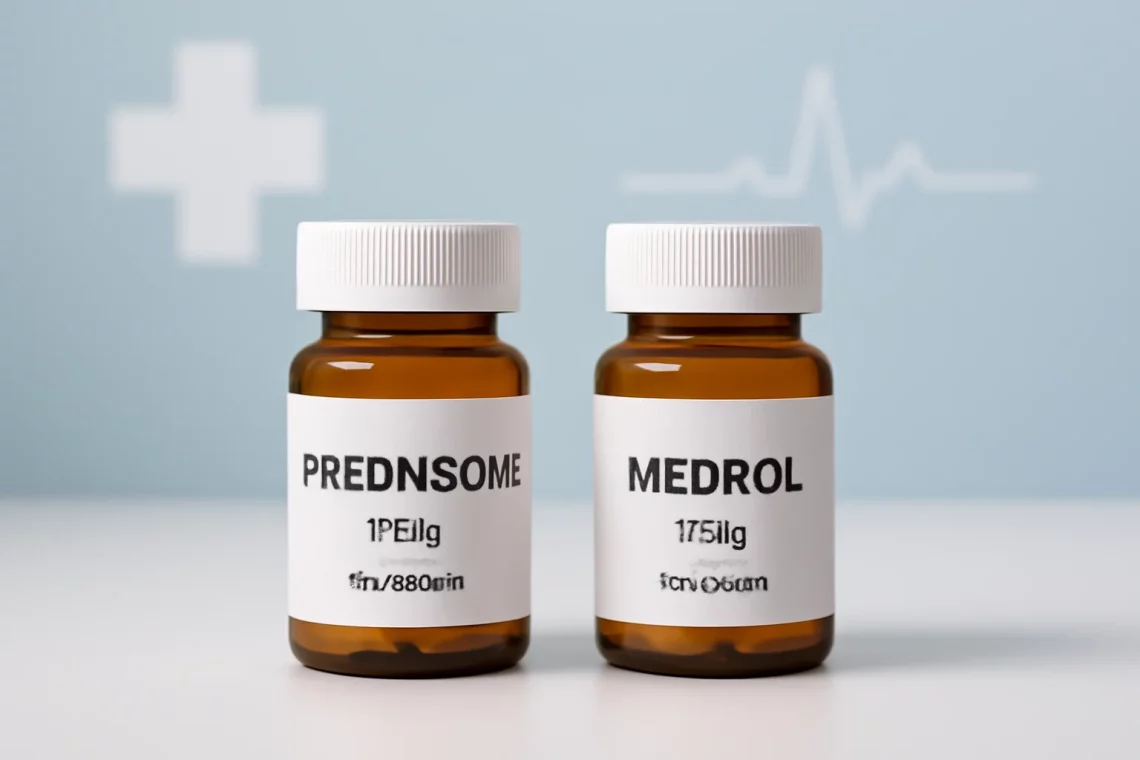
Prednisone vs Medrol: Key Differences and Uses Explained
Prednisone and Medrol are two widely used corticosteroids that play a significant role in the treatment of various medical conditions. Both medications are synthetically derived from naturally occurring hormones produced by the adrenal glands, and they possess powerful anti-inflammatory and immunosuppressive properties. The use of corticosteroids has become increasingly common in modern medicine, providing relief for patients suffering from autoimmune disorders, allergies, asthma, and a range of other inflammatory conditions. However, despite their similarities, Prednisone and Medrol exhibit distinct pharmacological profiles, dosing regimens, and side effect profiles that can influence their effectiveness and safety in individual patients.
As patients and healthcare providers navigate the complexities of these medications, understanding the nuances between Prednisone and Medrol becomes essential. The choice between the two may depend on several factors, including the specific condition being treated, the patient’s medical history, and the desired therapeutic outcomes. This article aims to explore the key differences and similarities between Prednisone and Medrol, shedding light on their uses, mechanisms of action, potential side effects, and considerations for patients and healthcare professionals alike.
Understanding Prednisone: Uses and Mechanism of Action
Prednisone is a synthetic corticosteroid that mimics the effects of cortisol, a hormone naturally produced by the adrenal glands. It is commonly prescribed for its anti-inflammatory and immunosuppressive properties, making it effective in treating a variety of conditions. Prednisone is often used to manage autoimmune disorders such as rheumatoid arthritis, lupus, and multiple sclerosis, as well as to alleviate symptoms of severe allergies, asthma, and certain skin conditions.
When administered, Prednisone is converted by the liver into its active form, prednisolone, which then interacts with specific receptors in the body. This interaction leads to a decrease in the production of inflammatory substances, effectively reducing swelling, redness, and pain associated with inflammatory conditions. The medication also suppresses the immune system, which can be beneficial in conditions where an overactive immune response contributes to disease progression.
Dosing for Prednisone can vary significantly depending on the condition being treated. It is typically prescribed in a tapering manner, starting with a higher dose that is gradually reduced over time to minimize potential withdrawal symptoms and side effects. Common side effects of Prednisone may include weight gain, mood changes, insomnia, and increased susceptibility to infections. Long-term use of corticosteroids such as Prednisone can lead to more serious complications, including osteoporosis and adrenal suppression, necessitating careful monitoring by healthcare providers.
Patients considering Prednisone should engage in a thorough discussion with their healthcare provider to weigh the benefits against potential risks and side effects. Individual responses to the medication can vary, making personalized treatment plans crucial for achieving optimal health outcomes.
Exploring Medrol: Applications and Pharmacology
Medrol, or methylprednisolone, is another synthetic corticosteroid that is often used in a similar manner to Prednisone. It shares many of the same therapeutic applications, including the treatment of inflammatory and autoimmune conditions, allergies, and certain types of cancers. Medrol is particularly favored in cases where a more potent anti-inflammatory effect is required or when patients may be sensitive to the side effects of other corticosteroids.
The pharmacological action of Medrol is akin to that of Prednisone, as it also targets the same glucocorticoid receptors in the body. By binding to these receptors, Medrol exerts its anti-inflammatory effects through the suppression of pro-inflammatory cytokines, inhibition of immune cell function, and reduction of inflammation at the cellular level. These actions help to alleviate symptoms associated with various conditions, including pain, swelling, and allergic reactions.
One of the notable differences between Medrol and Prednisone lies in their dosing and administration routes. Medrol can be administered orally, intramuscularly, or intravenously, providing flexibility in treatment based on the patient’s needs. The dosing schedule for Medrol may also be more straightforward, often involving a single daily dose that can simplify adherence for patients.
While Medrol is effective in managing a range of conditions, it is not without its side effects. Patients may experience weight gain, fluid retention, changes in mood, and increased blood sugar levels, among others. Like all corticosteroids, long-term use of Medrol can lead to complications, including adrenal insufficiency and increased risk of infection. Therefore, it is vital for patients to remain under the care of a healthcare provider when using this medication, ensuring regular monitoring and adjustments as necessary.
Comparing Side Effects: Prednisone vs. Medrol
Both Prednisone and Medrol come with a range of potential side effects, a common concern for patients prescribed corticosteroids. Understanding these side effects can help patients make informed decisions about their treatment options and encourage open communication with their healthcare providers.
Some common side effects associated with both medications include weight gain, fluid retention, increased appetite, and mood swings. These effects may be more pronounced with higher doses or prolonged use, leading to challenges in managing weight and overall health. Additionally, corticosteroids can impact blood sugar levels, which is particularly concerning for individuals with diabetes or those at risk of developing the condition.
While the side effect profiles of Prednisone and Medrol are similar, some patients may tolerate one medication better than the other. For instance, Medrol is often noted for having a potentially lower incidence of certain side effects, such as gastrointestinal irritation, making it a preferred choice for some patients. However, individual responses can vary significantly, necessitating careful monitoring and adjustment of dosages as needed.
Another critical consideration is the risk of adrenal suppression associated with long-term corticosteroid use. Both medications can disrupt the body’s natural production of cortisol, leading to potential withdrawal symptoms if the medication is abruptly discontinued. Healthcare providers typically recommend tapering doses gradually to minimize this risk and allow the adrenal glands to resume normal function.
Ultimately, the choice between Prednisone and Medrol should involve a comprehensive discussion between the patient and their healthcare provider, taking into account the specific condition being treated, the patient’s medical history, and their response to previous medications. By understanding the potential side effects and differences between these two corticosteroids, patients can make more informed choices about their treatment options.
Choosing the Right Medication: Factors to Consider
When it comes to selecting between Prednisone and Medrol, several factors come into play that can influence the decision-making process. These factors include the specific medical condition being treated, the patient’s overall health status, and their individual response to corticosteroids.
The underlying condition often dictates the choice of medication. For example, certain inflammatory conditions may respond better to one corticosteroid over another, or a patient may require a specific dosing regimen that aligns better with either Prednisone or Medrol. In cases where rapid control of inflammation is necessary, Medrol may be preferred due to its more potent anti-inflammatory effects.
Patients’ medical histories also play a crucial role in medication selection. Those with a history of adverse reactions to corticosteroids, pre-existing medical conditions, or concurrent medications may necessitate a more cautious approach. For instance, a patient with diabetes may need to consider how each medication affects blood sugar levels, making it essential to evaluate both the benefits and potential risks.
Moreover, treatment adherence can influence the choice of medication. Medrol’s dosing flexibility may be advantageous for patients who struggle with daily regimens or who require higher doses for acute conditions. Clear communication between the patient and healthcare provider about personal preferences, lifestyle, and treatment goals can aid in selecting the most appropriate medication.
Ultimately, the decision to use Prednisone or Medrol should be made collaboratively, ensuring that patients feel empowered and informed about their treatment options. By understanding the unique properties of each medication, patients and providers can work together to create a tailored treatment plan that maximizes therapeutic benefits while minimizing potential risks.
—
*Disclaimer: This article is for informational purposes only and should not be considered medical advice. Always consult with a healthcare professional for any medical concerns or questions regarding treatment options.*




